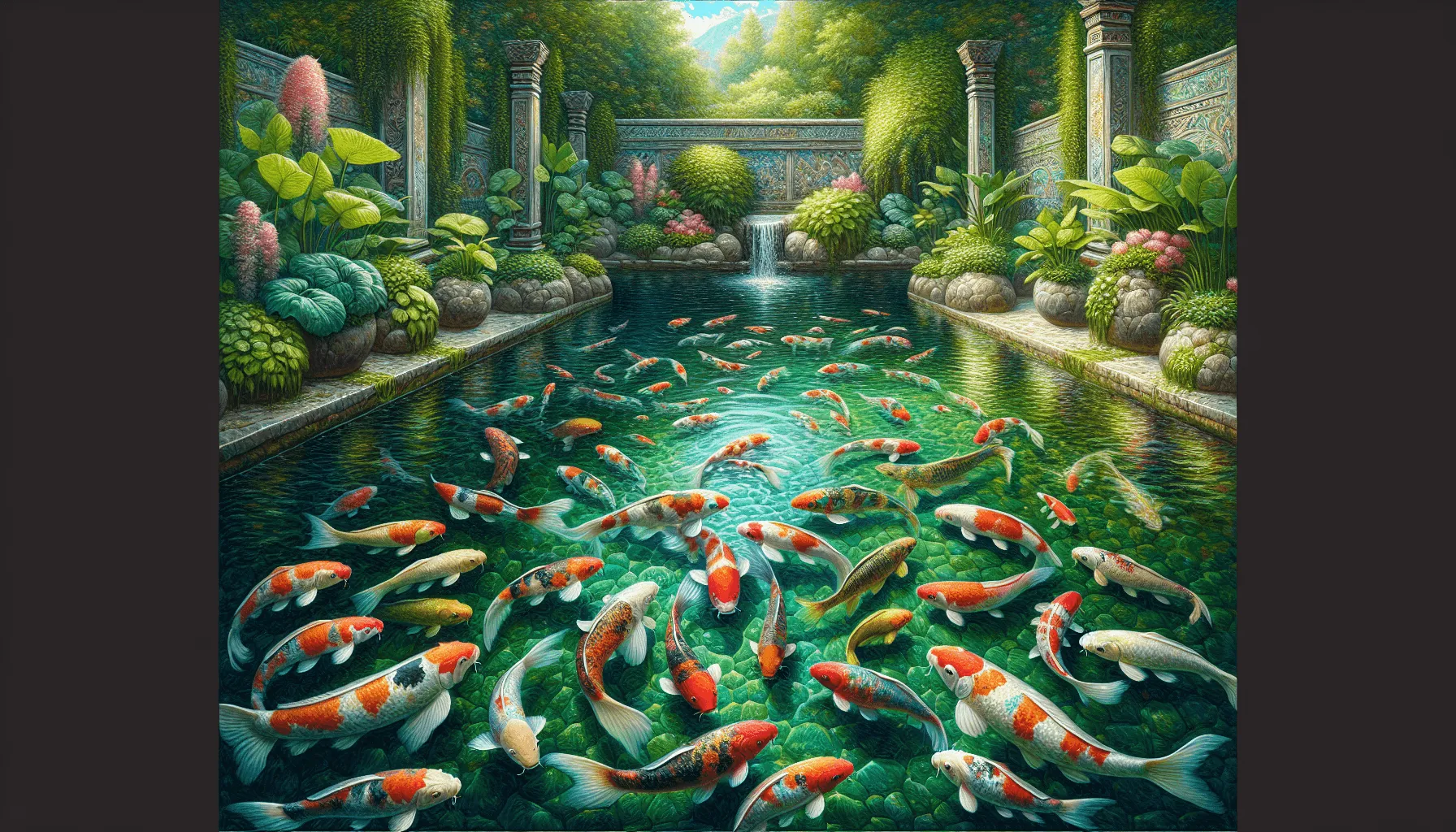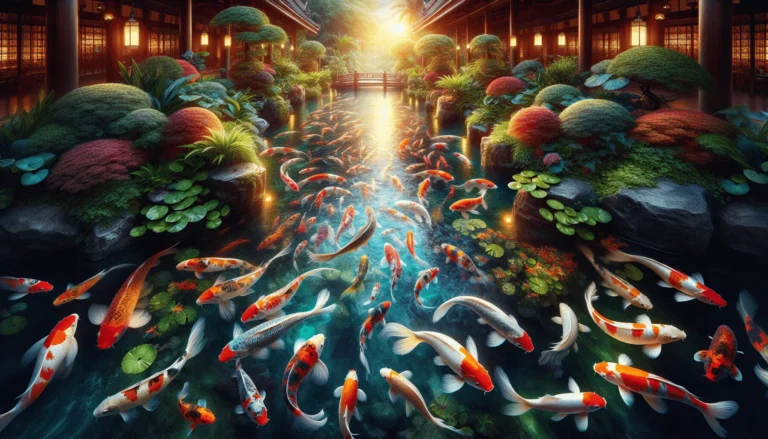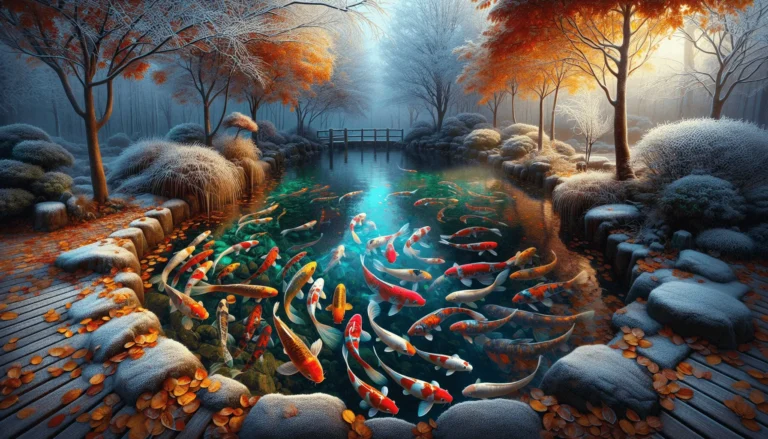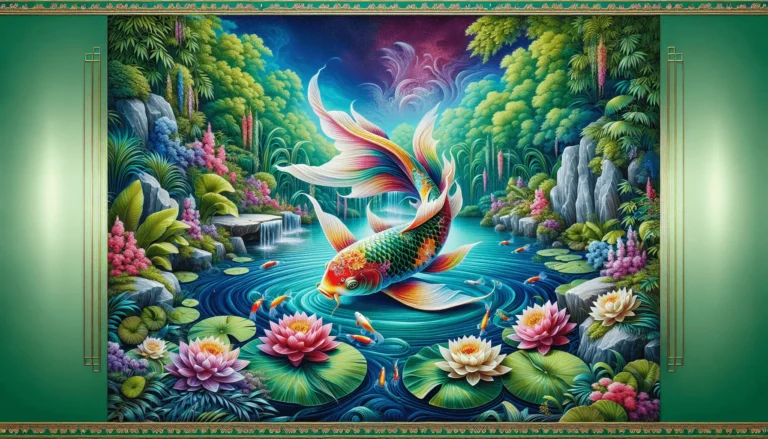Koi fishing in ponds has become a popular hobby for many enthusiasts. The vibrant colors and graceful movements of koi fish make them a captivating subject for pond owners. Knowing how to catch koi fish in a pond not only enhances your ability to manage your pond effectively but also ensures the well-being of these beautiful creatures.
In this article, we will share 10 proven tips to help you catch koi fish effectively and responsibly in your pond. These techniques cover everything from understanding koi behavior to selecting the right equipment. Whether you’re an experienced koi keeper or just starting out, you’ll find valuable insights that can make the process smoother and more successful.
1. Understanding Koi Behavior
Koi fish have distinct behavior patterns that are influenced by their pond environment. These decorative fish are social animals, often seen swimming in groups and interacting with each other and their surroundings.
Natural Instincts
Koi have a strong instinct to search for food, constantly looking for something to eat at the bottom of the pond. They are also naturally curious, often exploring new objects or changes in their habitat. Knowing these instincts can help you predict their movements.
Factors Affecting Koi Movement
Several factors influence koi behavior, including:
- Water Temperature: Koi are cold-blooded, meaning their activity levels change with water temperature. Warmer water generally makes them more active, while cooler temperatures slow them down.
- Time of Day: Koi are more active during early morning and late afternoon. These times are ideal for catching koi as they are more likely to be feeding and less cautious of potential dangers.
- Pond Features: The presence of plants, rocks, and other structures provides hiding places that affect how koi move around the pond.
Best Times for Fishing
To increase your chances of successfully catching koi, focus on:
- Early Morning or Late Afternoon: During these times, koi are actively feeding and less wary.
- Stable Weather Conditions: Avoid fishing during extreme weather changes as these can stress the fish and alter their usual patterns.
Understanding these aspects of koi behavior allows you to plan your fishing activities effectively, ensuring you approach them at the most opportune times. Additionally, it’s important to note that koi behavior can reveal a lot about the overall health of your pond. For instance, if your koi seem lethargic or are not eating as much, it could indicate issues with water quality or temperature.
2. Essential Equipment for Catching Koi
To effectively catch koi in your pond, it’s important to use the right equipment. The type of net you use can greatly affect how efficient and successful your koi fishing efforts are.
Types of Nets
Seine Nets
Seine nets are large, rectangular nets that are often used to encircle a group of fish and gradually draw them toward one end for capture.
Pros:
- Efficiency: Seine nets cover a wide area, making them ideal for capturing multiple koi at once.
- Control: They give you better control over the movement of the fish, guiding them into a confined space.
Cons:
- Size and Handling: These nets can be cumbersome due to their size, requiring more than one person to operate effectively.
- Water Depth: They may not be as effective in deeper ponds where koi have more room to evade capture.
Sock Nets
Sock nets are specially designed for handling individual koi, featuring a long, cylindrical sock shape that allows for gentle lifting and transport.
Pros:
- Gentle Handling: Sock nets minimize stress and injury by cradling the fish securely during removal.
- Transport: Ideal for transferring koi from one location to another without causing harm.
Cons:
- Limited Scope: They’re not suited for capturing multiple fish at once or in larger areas.
- Manual Effort: Requires careful maneuvering and may be less efficient compared to seine nets for initial captures.
Advantages of Specialized Nets
Using specialized nets designed specifically for catching koi provides several benefits:
- Enhanced Durability: High-quality materials like reinforced nylon ensure longevity, even with frequent use.
- Optimal Design: Features such as fine mesh prevent koi from getting entangled or injured.
- Ease of Use: Ergonomically designed handles and lightweight construction make these nets easier to maneuver.
Recommended Tools
Investing in high-quality nets can make a significant difference in your koi-catching experience. Here are some top recommendations:
- Matsuda NetsKnown for their durability and craftsmanship.
- Wooden handles provide a comfortable grip.
- Python Ulti-NetsLightweight yet robust construction.
- Fine mesh design perfect for preventing injuries.
Using the best nets for koi ensures that you handle your fish responsibly while maximizing your chances of successful capture.
Recommended Tools
Selecting the right equipment is crucial for successful koi capture. Among the best nets for koi, Matsuda and Python Ulti-Nets stand out due to their high quality and durability.
Matsuda Nets
- Made in Japan, these nets are renowned for their superior craftsmanship.
- Wooden handles provide a sturdy grip, ensuring ease of use.
- Durable mesh designed specifically for koi, reducing the risk of injury to the fish.
Python Ulti-Nets
- Lightweight construction, making them easy to handle.
- Flexible frame that adapts to different pond shapes and sizes.
- Fine mesh material, preventing damage to koi scales and fins.
Other Recommended Koi Nets
In addition to Matsuda and Python Ulti-Nets, there are other excellent options available. For instance, Swell Heavy Duty Round Koi Net offers robust construction suitable for larger koi. Similarly, Norfine Koi Nets are also highly recommended for their quality and effectiveness.
Investing in good tools like these cannot be overstated. High-quality nets not only improve your chances of successfully catching koi but also help minimize stress and injury to the fish. Using specialized nets ensures that capturing koi is both effective and humane, reinforcing the importance of using the right tools for the job.
3. Techniques for Efficient Koi Capture

Two-Person Approach
Working with a partner can significantly improve your chances of successfully catching koi. Coordination is key:
- Positioning: One person should be stationed at the shallow end or corner of the pond, while the other maneuvers around to guide the koi.
- Communication: Maintain clear communication to avoid startling the fish. Use hand signals or pre-agreed cues.
- Roles: Assign roles where one person corrals the koi with a guiding net, while the other stands ready with a larger net for capturing.
This method leverages teamwork to create a controlled environment, making it easier to catch koi.
Using Multiple Nets
Employing multiple nets can enhance efficiency and reduce stress on the fish:
- Guiding Techniques: Use one net to gently guide the koi towards a confined area. This net acts as a barrier, preventing escape.
- Capturing Net: Once the koi are guided into a smaller area, use a second net to capture them. This could be a sock net for easy lifting and transportation.
Best Practices:
- Keep movements slow and deliberate to avoid alarming the fish.
- Ensure that both nets are suitable in size; too small can make it difficult, while too large can be cumbersome.
Combining these techniques provides practical solutions for how to catch koi carp efficiently while minimizing stress and injury.
Additional Fishing Techniques
While these methods are effective for koi, they can also be adapted from other fishing styles. For instance, some fly fishing techniques could provide insights into handling these fish delicately during capture.
Moreover, understanding how to kill fish quickly can be beneficial if you plan on keeping them. Lastly, it’s worth noting that some strategies from Monster Hunter’s fishing guide might offer unique perspectives on capturing elusive fish like koi.
4. Preparing Your Pond for Koi Capture
Effective koi capture starts with proper pond preparation. Lowering water levels is a critical step that simplifies the process. By reducing the water volume, you limit the koi’s swimming space, making them easier to catch. This can be done by partially draining the pond, ensuring that the fish remain in a more concentrated area.
Clearing the catching area is equally important. Removing obstacles like plants and rocks can significantly facilitate the capture process. These elements often provide hiding spots for koi, complicating your efforts to catch them. Ensuring a clear, unobstructed area allows you to maneuver nets more easily and improves your chances of a successful capture.
Taking these preparatory steps ensures a smoother and more efficient koi-catching experience.
5. Baiting Techniques to Attract Koi
Effective Bait Options
To attract koi to a specific spot in your pond, you need the right bait. Here are some of the best options:
- Canned Corn: Highly effective due to its bright color and sweet flavor.
- Bread: A simple but reliable option, especially when combined with other baits.
- Specialized Koi Pellets: These are specifically designed for koi and can be very enticing.
Chumming Strategies
Creating a feeding frenzy can make it easier to lure koi into your nets. Here are some effective chumming methods:
- Scatter Bait Evenly: Distribute your chosen bait evenly over a small area to draw koi in without causing them to scatter.
- Use Floating Devices: Attach bait to floating objects in the pond. This keeps the bait at the surface, making it more visible and accessible to the fish.
- Gradual Feeding: Start by throwing small amounts of bait into the water to attract initial interest, then gradually increase the quantity.
Using these techniques, you can effectively gather koi in one area, simplifying the capture process.
6. Handling Koi Safely After Capture
Handling koi fish requires care to minimize stress and prevent injury. Here are some best practices:
- Use a Sock Net: Once caught, transfer koi to a sock net. This minimizes their movement and reduces the risk of injury.
- Support the Body: Always support the koi’s body with both hands. Avoid holding them by their fins or tails.
- Keep Them Wet: Ensure that your hands are wet before handling koi. Dry hands can damage their delicate skin and slime coat.
- Gentle Lifting: Lift the fish slowly and steadily, avoiding sudden movements that could startle them.
- Short Duration: Limit the time koi are out of water to reduce stress. Aim for less than a minute if possible.
- Transporting: Use a large container filled with pond water for transporting koi. Ensure the container is well-aerated.
These techniques for handling koi fish help in maintaining their health and well-being during and after capture.
Your patience and gentle touch make all the difference in ensuring a safe and humane capture process.
7. Patience and Calmness During the Process
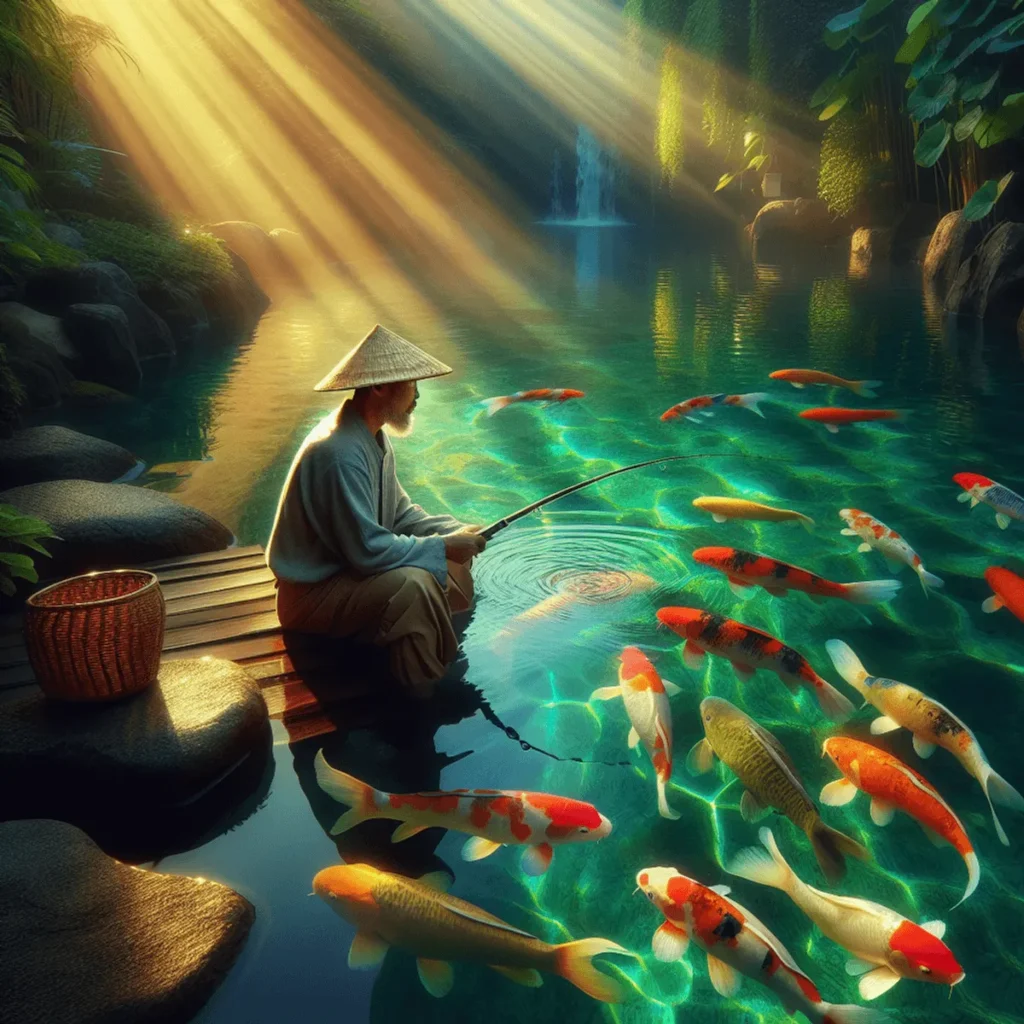
When catching koi carp, patience is crucial. Koi are skittish and easily startled, so a calm approach can make the difference between success and failure.
- Remain Still: Quick movements can spook koi, making them harder to catch. Standing still and moving slowly can help keep the fish calm.
- Quiet Environment: Minimize noise around the pond. Loud sounds or sudden disturbances can stress the fish, causing them to hide or flee.
- Gentle Movements: When positioning your net, use slow and deliberate actions to avoid alarming the koi. Guiding them gently toward your net increases your chances of a successful capture.
- Controlled Breathing: Keep your breathing steady to maintain a calm demeanor. Your body language affects how the fish perceive your presence.
Patience in fishing is not just about waiting; it’s about creating an environment where koi feel secure enough to be approached. By maintaining a calm approach, you enhance your ability to catch koi fish in your pond effectively.
Conclusion: Successful Koi Fishing Tips
Practicing these tips on how to catch koi fish in a pond responsibly ensures the well-being of both the fish and the ecosystem. Ethical fishing respects koi health, minimizes stress, and maintains pond harmony. Embrace patience and precision to enjoy the art of catching koi, transforming it into a rewarding hobby. Happy fishing!
FAQs (Frequently Asked Questions)
What are some effective techniques for catching koi fish in a pond?
To catch koi fish effectively, consider understanding their behavior, using the right equipment, and employing proper fishing techniques. Key methods include netting techniques, coordinating with a partner, and using multiple nets simultaneously.
What types of nets are best for catching koi?
The best nets for catching koi include seine nets and sock nets. Seine nets are ideal for larger areas, while sock nets are useful for targeted captures. Each type has its pros and cons, but using specialized nets designed for koi is crucial for successful capture.
How can I prepare my pond to make koi fishing easier?
Preparing your pond involves lowering water levels to concentrate the fish and removing obstacles like plants and rocks that can hinder the capture process. This creates a clearer area for fishing and increases your chances of success.
What bait is most effective for attracting koi?
Effective bait options for attracting koi include canned corn and other food items that they enjoy. Additionally, chumming strategies can be employed to create a feeding frenzy, luring the fish into your nets.
What should I keep in mind when handling koi after capture?
When handling koi after capture, it’s important to minimize stress and injury. Use gentle lifting techniques and transport them carefully to ensure their well-being during the process.
Why is patience important when fishing for koi?
Patience is crucial when fishing for skittish fish like koi carp. Maintaining a calm approach allows you to observe their behavior more effectively and increases your chances of a successful catch.

